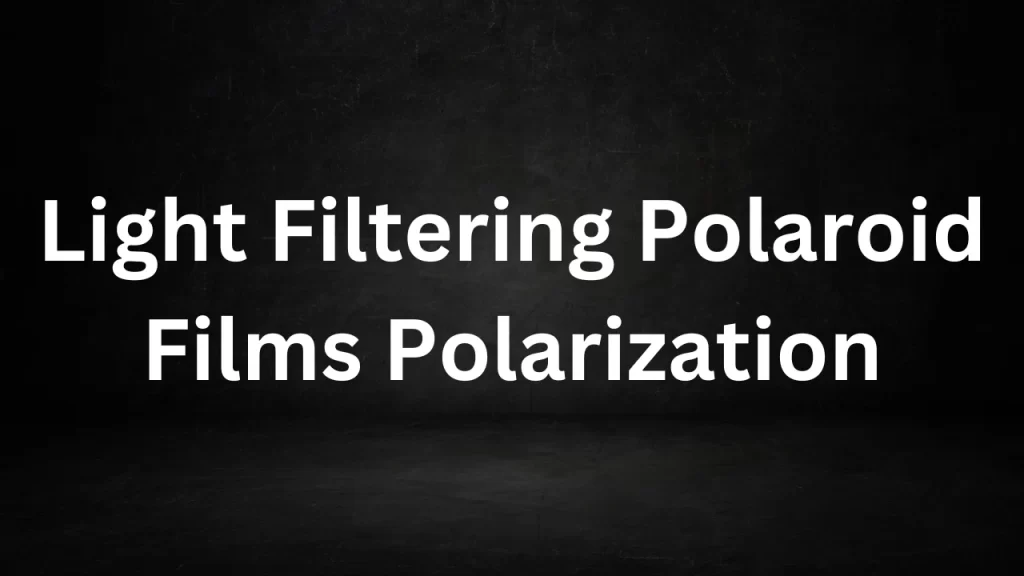Light Filtering Polaroid Films Polarization: Polarization is a fascinating phenomenon that plays a crucial role in various aspects of science and technology, particularly in the field of optics.
One of the practical applications of polarization is the use of Polaroid films to filter and manipulate light. In this article, we will explore the concept of polarization, how Polaroid films work, and their diverse applications in different industries.

Light Filtering Polaroid Films Polarization
Understanding Polarization
Light is composed of electromagnetic waves that oscillate in various directions perpendicular to the direction of propagation. Polarization refers to the orientation of these oscillations. When light waves oscillate in a specific direction, we say the light is polarized in that direction. Light from natural sources, such as the sun, is typically unpolarized, meaning its oscillations occur in all directions.
Polaroid Films and Polarization
Polaroid films, invented by Edwin Land in the 1930s, are specially designed materials that can selectively transmit or block polarized light. They consist of long-chain molecules that are aligned in a specific direction during the manufacturing process. These aligned molecules act as microscopic polarizing filters.
Here’s how Polaroid films work:
- Polarization by Absorption: Polaroid films are most commonly made by impregnating a transparent plastic sheet with iodine or another polarizing material. The long-chain molecules in the film selectively absorb light waves oscillating in one direction while allowing light waves oscillating perpendicular to that direction to pass through. This process essentially polarizes the transmitted light.
- Blocking Unwanted Light: When unpolarized light passes through a Polaroid film, it becomes polarized in the direction allowed by the film. Light waves oscillating in other directions are absorbed by the film, effectively blocking them.
Applications of Polaroid Films
Polaroid films have a wide range of practical applications across various fields:
- Sunglasses: Polarized sunglasses use Polaroid films to reduce glare from surfaces like water and roads. They block horizontally polarized light, which is often responsible for the blinding glare that can be uncomfortable and hazardous.
- Photography and Cameras: Polarizing filters can be attached to camera lenses to control reflections, enhance color saturation, and improve the contrast in photographs. They are particularly useful for landscape and outdoor photography.
- Liquid Crystal Displays (LCDs): LCD screens, including those in TVs, computer monitors, and smartphones, use polarization to control the passage of light and create images with vibrant colors and high contrast.
- 3D Glasses: Polaroid films are used in 3D glasses to present different images to each eye, creating the illusion of depth in 3D movies and games.
- Microscopy: Polarized light microscopy is used in scientific research and materials analysis to study the birefringence of specimens, revealing structural and compositional information.
- Communication Devices: Polarization is employed in various optical and communication devices, such as optical filters, signal modulators, and polarizing beam splitters.
Conclusion
Polarization and Polaroid films are essential components in optics and light management. They allow us to manipulate light waves, reduce glare, enhance image quality, and explore the properties of materials. Whether in everyday sunglasses, high-tech LCD displays, or advanced scientific instruments, the power of polarization through Polaroid films continues to shape the way we interact with and understand light.
Read More
- Animals Biology Science Lion Zoology
- Difference Between Voltage And Current
- Difference Between Two Stroke And Four Stroke
- Difference Between Ac And Dc
- Changing The Period Of A Pendulum
Frequently Asked Questions (FAQs) Light Filtering Polaroid Films Polarization
What is polarization in the context of light?
Polarization refers to the orientation of oscillations of light waves. It indicates the direction in which the electromagnetic waves oscillate as they propagate through space.
How do Polaroid films work to filter light?
Polaroid films consist of long-chain molecules that are aligned during manufacturing. These aligned molecules selectively absorb light waves oscillating in one direction while allowing light waves oscillating perpendicular to that direction to pass through, effectively polarizing the transmitted light.
What are some common applications of Polaroid films?
Polaroid films are used in sunglasses to reduce glare, in photography to control reflections and enhance image quality, in LCD screens to create vibrant and high-contrast images, in 3D glasses to provide the illusion of depth, and in scientific research for microscopy and materials analysis, among other applications.
How do Polaroid sunglasses reduce glare?
Polarized sunglasses block horizontally polarized light, which is often responsible for glare from surfaces like water, roads, and glass. By selectively allowing vertically polarized light to pass through, they reduce the blinding effect of glare.
Can Polaroid films be used to improve the visibility of LCD screens?
Yes, Polaroid films are used in LCD screens to control the passage of light, enhance color saturation, and improve contrast, resulting in brighter and more vibrant displays.
